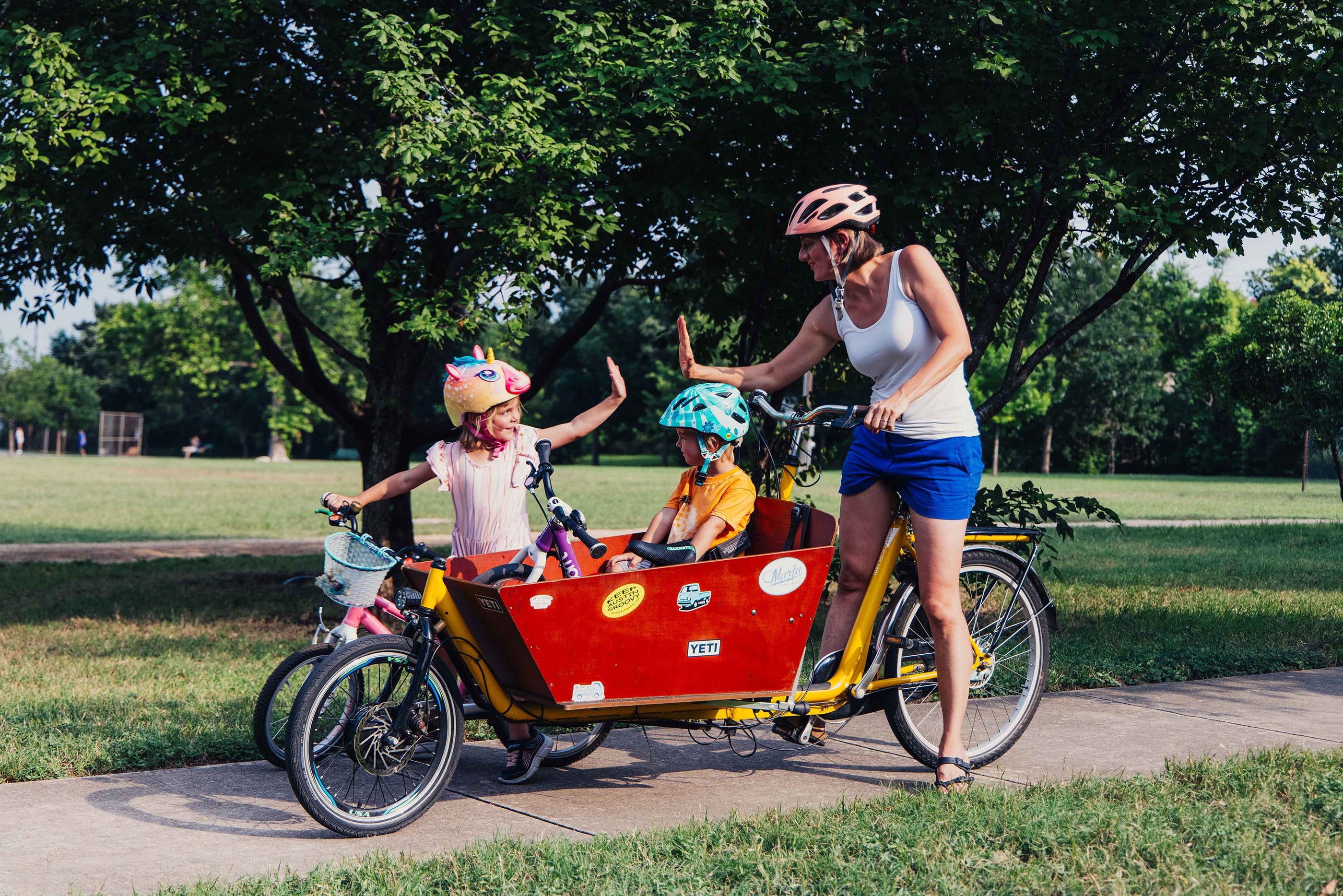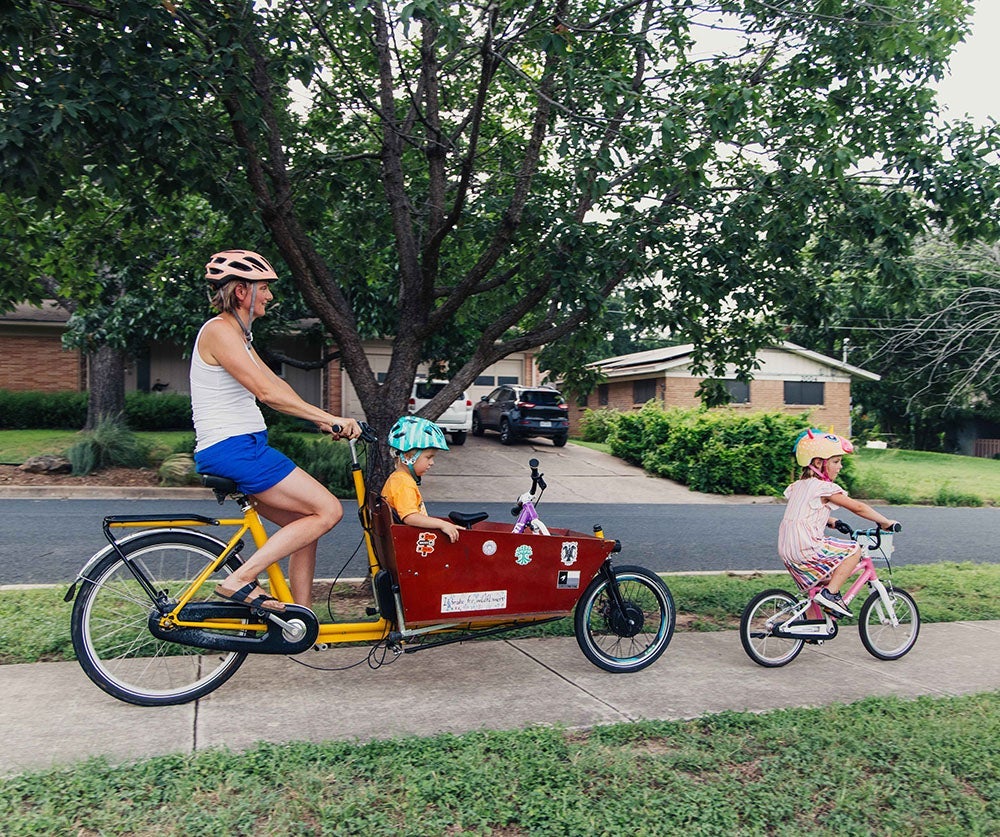More Than a Hobby
Customer Spotlight: Astrid Rooselaer

In the US, arriving at school by bicycle is rare. Not quite as rare as an albino deer or a Lincoln Wheat penny, but still – those arriving by bike only account for 1.1% of students in the US. And while we can’t say for sure how many kiddos arrive in a bakfiets, it’s no doubt way less!
“All the other parents know me because I'm the girl with the bakfiets,” Astrid declares with a smile, reflecting on the school drop-off lines that she breezes through every school day.
For Astrid, growing up in Belgium, a bicycle was so much more than a hobby. In fact, it was her primary means of transportation, well into her adult life. “I was born there, and I grew up there [in Belgium], then I moved to the US in the fall of 2015. And here I had my first car; I never owned a car before. I just did everything by bike.”
It can’t be denied; the way people get around in the US looks a lot different than in other parts of the world. Some of these differences can be attributed to our spread-out geography and the proliferation of car-dependent infrastructure, but some of it is cultural.
Throughout Europe, a much larger share of everyday trips are taken on foot or by bike when compared to the US. Astrid is quick to let you know this mindset wasn’t unique to her family. “I would say almost every family probably from Belgium is a bike family. We're a little bit like the Netherlands.”
That said, a healthy appreciation for bicycles has permeated Astrid’s family in other ways. Her brother Thomas owns a bike shop in Deinze, Belgium, aptly named Thomas Cycles – one of the largest woom bike retailers in the nation, in fact.
Bikes Are More Than a Toy
With her background, Astrid knew firsthand that bikes are not just kids’ toys. So when it came time to get her own kiddos on two wheels, she knew that the details mattered. Astrid quickly realized the difference a premium, lightweight kids’ bike made during those tender early stages of learning to ride.
“Before we had a woom bike, I had this other kids’ bike that was given to me. It was bigger than our balance bike, and it was very heavy. I had to kind of push her to try to ride it. It just wasn't a good situation. And that's how most other kids’ bikes are. So I'm so glad that woom exists because it does change the entire experience.”
We couldn’t agree more! When children are first introduced to the world of cycling, they haven’t experienced the magic yet. They are still forming opinions on whether riding a bike is fun, scary, intimidating, or awkward – and the right bike can make all the difference during this critical period.
How the Rooselaer Kids Learned to Ride
Learning how to ride a bike tends to be a little different for each unique individual (different spokes for different folks). When it came to Ella and Remi neither kid used training wheels. Still, their journeys were not always parallel:
Ella - learned to balance on a woom 3 with pedals off
- Transitioned from woom 3 with pedals off to woom 3 with pedals on
- “She went from another brand’s balance bike to a woom 3. She learned to balance on her woom bike, and then when she was comfortable we put the pedals on.”
Remi - learning to balance on a woom 1 balance bike
- Transitioning from woom 1 balance bike to woom 2 pedal bike
- “He wants to try the bigger one, but then after a while he wants to go back to the smaller one. He is still getting more comfortable with the height of the (woom 2).”
The Ride vs. The Destination
Astrid uses her bakfiets in a super practical manner – it’s essentially her two-wheeled mini-van that she uses to haul her kids to school, the park, or the library. However, thinking of it only as a utilitarian tool would be limiting… it’s also a pure blast to ride, and capable of unexpectedly sparking joy:
“Once my kids and I went to a birthday party which was at a park where we go. And so I took my bike and all the kids wanted to ride in it. I became the entertainment of the birthday party, and just took it around the park giving rides. Then when it was my son's time for a birthday party, that's what we did. We just attached balloons to the bike and took his friends around for rides… the three-year-olds just loved it!”
Stories like this remind us that sometimes a bike is the way to get to a destination, but other times the bike is the destination. It’s important to remember: both of those are totally valid ways to enjoy the ride.
Not only do Astrid’s kids see their mother using her bike on a daily basis for school commutes and other errands, but they’re also getting fun, formative experiences riding their own woom bikes. Astrid made sure to provide her kiddos with a top-notch backyard bike track to build fine motor skills – the same kind of hijinks she and her sister got into growing up…
“In the summer when I have a lot of cardboard boxes, I’ll make a track for them. So they follow the cardboard lanes, or I make little streets in our carport with chalk that they can ride on with their bikes. Because in the past that's what I would do. I would build my own ramps in my backyard, bike on it, make a whole bike track, and then invite my sister to do it, and if she could do it then I'd give her a medal.”
As her own children are learning how bikes fit into the world, Astrid gives them plenty of exposure to both elements of cycling – practical riding (i.e. using the bike to get from A to B) as well as joyriding.
“I think for them right now, they see it as more of a toy, but since they see me use my bike all the time as a tool, in the future it'll be a tool. I'm sure they'll think of it that way.”
Bikes Kids Want to Ride
Most kids receive a bicycle at some point in adolescence. It starts out as just a toy. Like toys, there’s a good chance it’s cast aside, maybe it gets a name inscribed on it, and perhaps it even becomes a truly beloved toy. But whether their bike graduates beyond the realm of ‘toyhood’ and transforms into a trusted tool, well… that depends on quite a few factors.
Like Astrid proved with her bakfiets, you need the right bike for the right job. Not only was her Dutch cargo bike designed specifically to haul large loads, but she also had it retrofitted with an electric motor, “for the hills and the heat in the summer.” Anyone who’s lived through a Texas summer will surely get that.
Getting the right bike for an early rider’s first time on two wheels is just as critical – especially if you want them to fall in love with cycling and see it as much more than a hobby later down the road. It’s hard to understate the impact of a kid starting out on a lightweight bicycle with components designed specifically for children.
“I just love that they're incredibly light. You can tell that they really want to ride the bike. It's just so fun for them to be independent … and to see her self-confidence when she was first able to ride it. That was such a milestone for her. You should have seen her face when she was able to do that.”


